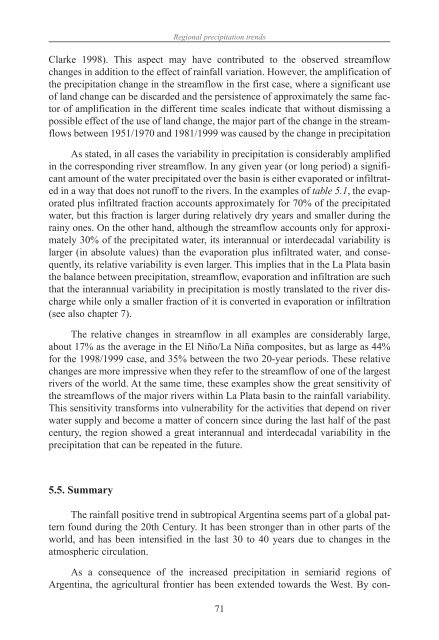chapter - Atmospheric and Oceanic Science
chapter - Atmospheric and Oceanic Science
chapter - Atmospheric and Oceanic Science
Create successful ePaper yourself
Turn your PDF publications into a flip-book with our unique Google optimized e-Paper software.
Clarke 1998). This aspect may have contributed to the observed streamflow<br />
changes in addition to the effect of rainfall variation. However, the amplification of<br />
the precipitation change in the streamflow in the first case, where a significant use<br />
of l<strong>and</strong> change can be discarded <strong>and</strong> the persistence of approximately the same factor<br />
of amplification in the different time scales indicate that without dismissing a<br />
possible effect of the use of l<strong>and</strong> change, the major part of the change in the streamflows<br />
between 1951/1970 <strong>and</strong> 1981/1999 was caused by the change in precipitation<br />
As stated, in all cases the variability in precipitation is considerably amplified<br />
in the corresponding river streamflow. In any given year (or long period) a significant<br />
amount of the water precipitated over the basin is either evaporated or infiltrated<br />
in a way that does not runoff to the rivers. In the examples of table 5.1, the evaporated<br />
plus infiltrated fraction accounts approximately for 70% of the precipitated<br />
water, but this fraction is larger during relatively dry years <strong>and</strong> smaller during the<br />
rainy ones. On the other h<strong>and</strong>, although the streamflow accounts only for approximately<br />
30% of the precipitated water, its interannual or interdecadal variability is<br />
larger (in absolute values) than the evaporation plus infiltrated water, <strong>and</strong> consequently,<br />
its relative variability is even larger. This implies that in the La Plata basin<br />
the balance between precipitation, streamflow, evaporation <strong>and</strong> infiltration are such<br />
that the interannual variability in precipitation is mostly translated to the river discharge<br />
while only a smaller fraction of it is converted in evaporation or infiltration<br />
(see also <strong>chapter</strong> 7).<br />
The relative changes in streamflow in all examples are considerably large,<br />
about 17% as the average in the El Niño/La Niña composites, but as large as 44%<br />
for the 1998/1999 case, <strong>and</strong> 35% between the two 20-year periods. These relative<br />
changes are more impressive when they refer to the streamflow of one of the largest<br />
rivers of the world. At the same time, these examples show the great sensitivity of<br />
the streamflows of the major rivers within La Plata basin to the rainfall variability.<br />
This sensitivity transforms into vulnerability for the activities that depend on river<br />
water supply <strong>and</strong> become a matter of concern since during the last half of the past<br />
century, the region showed a great interannual <strong>and</strong> interdecadal variability in the<br />
precipitation that can be repeated in the future.<br />
5.5. Summary<br />
Regional precipitation trends<br />
The rainfall positive trend in subtropical Argentina seems part of a global pattern<br />
found during the 20th Century. It has been stronger than in other parts of the<br />
world, <strong>and</strong> has been intensified in the last 30 to 40 years due to changes in the<br />
atmospheric circulation.<br />
As a consequence of the increased precipitation in semiarid regions of<br />
Argentina, the agricultural frontier has been extended towards the West. By con-<br />
71






